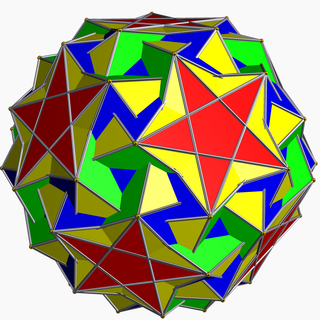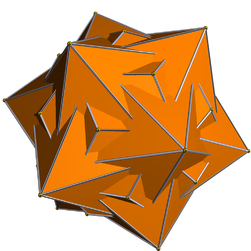Snub icosidodecadodecahedron
| Snub icosidodecadodecahedron | |
|---|---|
 | |
| Type | Uniform star polyhedron |
| Elements | F = 104, E = 180 V = 60 (χ = −16) |
| Faces by sides | (20+60){3}+12{5}+12{5/2} |
| Coxeter diagram |     |
| Wythoff symbol | | 5/3 3 5 |
| Symmetry group | I, [5,3]+, 532 |
| Index references | U46, C58, W112 |
| Dual polyhedron | Medial hexagonal hexecontahedron |
| Vertex figure |  3.3.3.5.3.5/3 |
| Bowers acronym | Sided |

In geometry, the snub icosidodecadodecahedron is a nonconvex uniform polyhedron, indexed as U46. It has 104 faces (80 triangles, 12 pentagons, and 12 pentagrams), 180 edges, and 60 vertices.[1] As the name indicates, it belongs to the family of snub polyhedra.
The circumradius of the snub icosidodecadodecahedron with unit edge length is
Cartesian coordinates
Cartesian coordinates for the vertices of a snub icosidodecadodecahedron are all the even permutations of
with an even number of plus signs, where is the golden ratio; ρ is the plastic ratio, or the unique real solution to ρ3 = ρ + 1;
Related polyhedra
Medial hexagonal hexecontahedron
| Medial hexagonal hexecontahedron | |
|---|---|
 | |
| Type | Star polyhedron |
| Face |  |
| Elements | F = 60, E = 180 V = 104 (χ = −16) |
| Symmetry group | I, [5,3]+, 532 |
| Index references | DU46 |
| dual polyhedron | Snub icosidodecadodecahedron |

The medial hexagonal hexecontahedron is a nonconvex isohedral polyhedron. It is the dual of the uniform snub icosidodecadodecahedron.
See also
References
- ^ Maeder, Roman. "46: snub icosidodecadodecahedron". MathConsult.
- ^ Weisstein, Eric W. "Snub icosidodecadodecahedron". MathWorld.
- ^ Skilling, John (1975), "The complete set of uniform polyhedra", Philosophical Transactions of the Royal Society A, 278 (1278): 111–135, doi:10.1098/rsta.1975.0022.
- Wenninger, Magnus (1983), Dual Models, Cambridge University Press, ISBN 978-0-521-54325-5, MR 0730208
External links
- Weisstein, Eric W. "Medial hexagonal hexecontahedron". MathWorld.
- v
- t
- e
polyhedra (nonconvex
regular polyhedra)
of Kepler-Poinsot
polyhedra
hemipolyhedra
uniform polyhedra
- medial rhombic triacontahedron
- small stellapentakis dodecahedron
- medial deltoidal hexecontahedron
- small rhombidodecacron
- medial pentagonal hexecontahedron
- medial disdyakis triacontahedron
- great rhombic triacontahedron
- great stellapentakis dodecahedron
- great deltoidal hexecontahedron
- great disdyakis triacontahedron
- great pentagonal hexecontahedron
uniform polyhedra with
infinite stellations
 | This polyhedron-related article is a stub. You can help Wikipedia by expanding it. |
- v
- t
- e

![{\displaystyle {\begin{array}{crrrc}{\Bigl (}&\pm \,2\alpha ,&\pm \,2\gamma ,&\pm \,2\beta &{\Bigr )},\\{\Bigl (}&\pm {\bigl [}\alpha +{\frac {\beta }{\varphi }}+\gamma \varphi {\bigr ]},&\pm {\bigl [}-\alpha \varphi +\beta +{\frac {\gamma }{\varphi }}{\bigr ]},&\pm {\bigl [}{\frac {\alpha }{\varphi }}+\beta \varphi -\gamma {\bigr ]}&{\Bigr )},\\{\Bigl (}&\pm {\bigl [}-{\frac {\alpha }{\varphi }}+\beta \varphi +\gamma {\bigr ]},&\pm {\bigl [}-\alpha +{\frac {\beta }{\varphi }}-\gamma \varphi {\bigr ]},&\pm {\bigl [}\alpha \varphi +\beta -{\frac {\gamma }{\varphi }}{\bigr ]}&{\Bigr )},\\{\Bigl (}&\pm {\bigl [}-{\frac {\alpha }{\varphi }}+\beta \varphi -\gamma {\bigr ]},&\pm {\bigl [}\alpha -{\frac {\beta }{\varphi }}-\gamma \varphi {\bigr ]},&\pm {\bigl [}\alpha \varphi +\beta +{\frac {\gamma }{\varphi }}{\bigr ]}&{\Bigr )},\\{\Bigl (}&\pm {\bigl [}\alpha +{\frac {\beta }{\varphi }}-\gamma \varphi {\bigr ]},&\pm {\bigl [}\alpha \varphi -\beta +{\frac {\gamma }{\varphi }}{\bigr ]},&\pm {\bigl [}{\frac {\alpha }{\varphi }}+\beta \varphi +\gamma {\bigr ]}&{\Bigr )},\end{array}}}](https://wikimedia.org/api/rest_v1/media/math/render/svg/10921e1e8fdeb7d32b76f5ed00f6106fe9e10cd5)

![{\displaystyle {\begin{aligned}\alpha &=\rho +1=\rho ^{3},\\[4pt]\beta &=\varphi ^{2}\rho ^{4}+\varphi ,\\[4pt]\gamma &=\rho ^{2}+\varphi \rho .\end{aligned}}}](https://wikimedia.org/api/rest_v1/media/math/render/svg/b9b2d6457e955f558a53b8e445cd2711d3a698ee)











